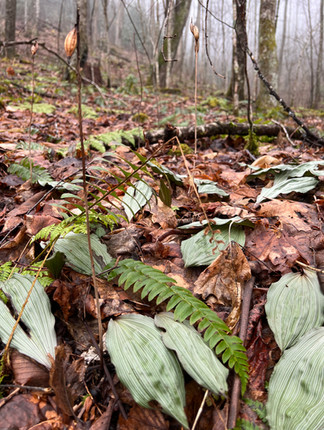The Adam and Eve Orchid
- Kimberly Hainge
- Feb 28, 2023
- 3 min read
One of the striking native orchids that can be spotted in mid-winter is the Puttyroot orchid or Adam and Eve orchid. The Latin name for this interesting orchid is Aplectrum hyemale. Hyemale is derived from another Latin word that refers to the winter leaf of the plant. This species is the lone representative of its genus in North America. I was introduced to this orchid one winter when I stumbled upon a patch off thinly striped green leaves growing about twenty feet above a small shaded stream.
Like the Cranefly orchid, which was discussed in an earlier blog, the flower stem is leafless and only very rarely do the leaves remain when the orchid flowers. In the fall what you may find is a brown stem topped by a fat seed capsule that is all dried out. You can sometimes see a group of these capsules sticking up from the ground and it can clue you in on a new population’s location. Depending on elevation, the plant blooms in mid-April through the end of May.
Where does the name Putty Root come from? The root of the orchid, called a corm, has a putty like consistency when you cut it open. The orchid spreads underground through the growth of its corms, which are often linked by rhizomes and can release a sticky substance when crushed. Interestingly, this sticky substance was once used to mend broken pottery.
What about the Adam and Eve common name? At the end of the season the corm does not completely go away before a new one is formed. The old one, slowly withering away, remains attached to the new corm that is forming. Some people compare their appearance to the concept of Eve’s connection with Adam’s rib!
This orchid was used for medicine by the American Indians. The roots were used in a poultice for boils and a tea was used for bronchial troubles. I noticed that nothing was mentioned about the corm being edible, but a single old plant book I found claimed that the corm was indeed possible to eat. When I saw how sticky the corms were, I suspect that unless you were starving to death, it would not be a plant you would choose to sample. One last thing, the roots of this plant were used to attract a lover or to discourage rivals. The user was instructed to carry the roots in a small bag at all times.
The Puttyroot orchid is not rare but can be found rather commonly once you know what to watch for. The leaves are large; 8-10 inches long. When they first emerge in the winter months the stripes appear purple or reddish between the green parts of the leaves. As the leaf ages, the strips fade until they look almost white.
The flowers, when examined through a hand lens, closely resemble the flowers of a gorgeous orchid in our area called a Yellow-Fringed Orchid, but it lacks what is called a spur and also lacks the brilliant color of the Fringed Orchids. The Puttyroot’s blossoms, that grow singly up and down the stalk, are yellow and green and tend to blend beautifully into the background of the forest undergrowth. There is no fragrance or nectar and it is still a bit of a mystery about what is pollinating the orchid. Sweat bees, the tiny bees that are iridescent and have a potent sting, are thought to be one candidate. As the flower matures, the column bends over and presses the flowers pollen onto its stigma. In order for pollination to occur, however, the little cap on the anther that covers the pollen, has to be removed. So it is thought that the bee or perhaps an ant has to be involved in the process. There is not a lot of genetic variation in a population and this supports the theory that the plant is self-pollinized, perhaps with just a little help.
One of my favorite books on Native Orchids is by Stanley L. Bentley. It is titled Native Orchids of the Southern Appalachian Mountains.










Comments